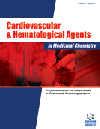- Home
- A-Z Publications
- Cardiovascular & Hematological Agents in Medicinal Chemistry (Formerly Current Medicinal Chemistry - Cardiovascular & Hematological Agents)
- Previous Issues
- Volume 12, Issue 1, 2014
Cardiovascular & Hematological Agents in Medicinal Chemistry (Formerly Current Medicinal Chemistry - Cardiovascular & Hematological Agents) - Volume 12, Issue 1, 2014
Volume 12, Issue 1, 2014
-
-
Novel oral Anticoagulants in Non-Valvular Atrial Fibrillation
More LessAtrial fibrillation is the most frequent arrhythmia in clinical practice, reaching 2% of the people in the world and is associated with systemic embolism. Thus, the use of anticoagulants is indicated if CHA2DS2-VASc score ≥2 or in patients with previous transient ischemic attack or stroke. For decades, warfarin, a vitamin K antagonist, was the only choice for chronic oral anticoagulation. Recently, novel oral anticoagulants ( Read More
-
-
-
Safety and Efficacy of Novel Oral Anticoagulants: A Comparison to Vitamin K Antagonists
More LessAuthors: Antonios Katsianis, Emmanouil Petrou, Anna Kostopoulou and George TheodorakisNovel oral anticoagulants (NOACs) have been developed as alternatives for vitamin K antagonists (VKAs) for the prevention of thromboembolic events in patients with a variety of medical conditions. In this review, we summarize the current data on NOACs safety and efficacy compared to VKAs and in specific patients’ groups including heart valve replacement, venous thromboembolism, advanced renal failure and the elderly.
-
-
-
Acute Coronary Syndromes in Patients with Atrial Fibrillation and Heart Failure. Could Novel Oral Anticoagulants be the Solution of the Optimal Antithrombotic Therapy Puzzle?
More LessAuthors: Maria Boutsikou, Chrysafios Girasis, Emmanouil Petrou and Gregory PavlidesThe patients experiencing an acute coronary event are exposed to increased risk of thromboembolic events. That risk becomes substantially greater when AF fibrillation and heart failure are present as well. Dual antiplatelet therapy remains the gold standard in the treatment of patients with ACS. The combination of an oral anticoagulant agent with dual antiplatelet therapy is proven to be more effective in prevention of f Read More
-
-
-
Novel Oral Anticoagulants in Peripheral Arterial and Coronary Artery Disease
More LessAuthors: Angelos Tsipis, Anna-Maria Athanassiadou, Emmanouil Petrou and Ioannis IakovouAtherosclerosis comprises of a chronic disease of the vessels which mainly targets the arterial system. The disease’s main characteristic is the accumulation of inflammatory cells, lipids, smooth muscle cells and connective tissue within the vascular intima layer. The atherosclerotic lesion can be more accurately defined as a fibro-inflammatory lipid plaque. The pathogenesis of the atherosclerotic plaque is a progressive an Read More
-
-
-
Novel Oral Anticoagulants in the Management of Polycythemia Vera and Essential Thrombocythemia
More LessAuthors: Vasiliki Karali and Panayiotis PanayiotidisPolycythemia vera and essential thrombocythemia comprise myeloproliferative neoplasms, the main characteristic of which is an over-production of bone marrow myeloid lineage cells. The diseases typically involve thrombosis and their treatment, apart from the strictly hematological aspect, involves antithrombotic agents. In this review we aspire to present the possible role of the newly developed oral anticoagulants in the tr Read More
-
-
-
G Protein-Coupled Receptors – Potential Roles in Clinical Pharmacology
More LessAuthors: Megan Kypreos, Teesta Banerjee and Debabrata MukherjeeG protein-coupled receptors (GPCRs) constitute several membrane proteins that are turned on by hormones and neurotransmitters to trigger cellular signaling pathways. GPCRs have been targeted in the development of several drugs but the therapeutic potential of these proteins remains underutilized. Most drugs to date have targeted the class A, or the rhodopsin family of GPCRs, but recently the Class B, i.e., the secretin Read More
-
-
-
Oral Anticoagulation in Atrial Fibrillation
More LessAuthors: Julia G. Ansari, Gurkaran S. Garcha and Nasser LakkisAtrial fibrillation affects approximately 5 million patients in the United States. The rate of stroke in adults with atrial fibrillation depending on their risk factors varies between 1-20% annually. Anticoagulation with vitamin K antagonists such as warfarin has been the mainstay therapy but it is cumbersome and requires close follow-up. Since 2010, three new oral anticoagulants have received Food and Drug Administration appr Read More
-
-
-
Emerging Therapy Options in Heparin-Induced Thrombocytopenia
More LessAuthors: Ranjit K. Chaudhary, Nabin Khanal, Smith Giri, Ranjan Pathak and Vijaya R. BhattHeparin-induced thrombocytopenia (HIT) is a life and limb-threatening thrombotic complication of heparin, which is the result of platelet activation by anti-PF4/heparin antibodies. With lepirudin and danaparoid no longer available in the US, treatment options are limited to argatroban, fondaparinux (off-label use) and bivalirudin (for patients undergoing percutaneous coronary intervention). Both argatroban and bivalirud Read More
-
Volumes & issues
-
Volume 23 (2025)
-
Volume 22 (2024)
-
Volume 21 (2023)
-
Volume 20 (2022)
-
Volume 19 (2021)
-
Volume 18 (2020)
-
Volume 2 (2020)
-
Volume 17 (2019)
-
Volume 16 (2018)
-
Volume 15 (2017)
-
Volume 14 (2016)
-
Volume 13 (2015)
-
Volume 12 (2014)
-
Volume 11 (2013)
-
Volume 10 (2012)
-
Volume 9 (2011)
-
Volume 8 (2010)
-
Volume 7 (2009)
-
Volume 6 (2008)
-
Volume 5 (2007)
-
Volume 4 (2006)
Most Read This Month
Article
content/journals/chamc
Journal
10
5
false
en


